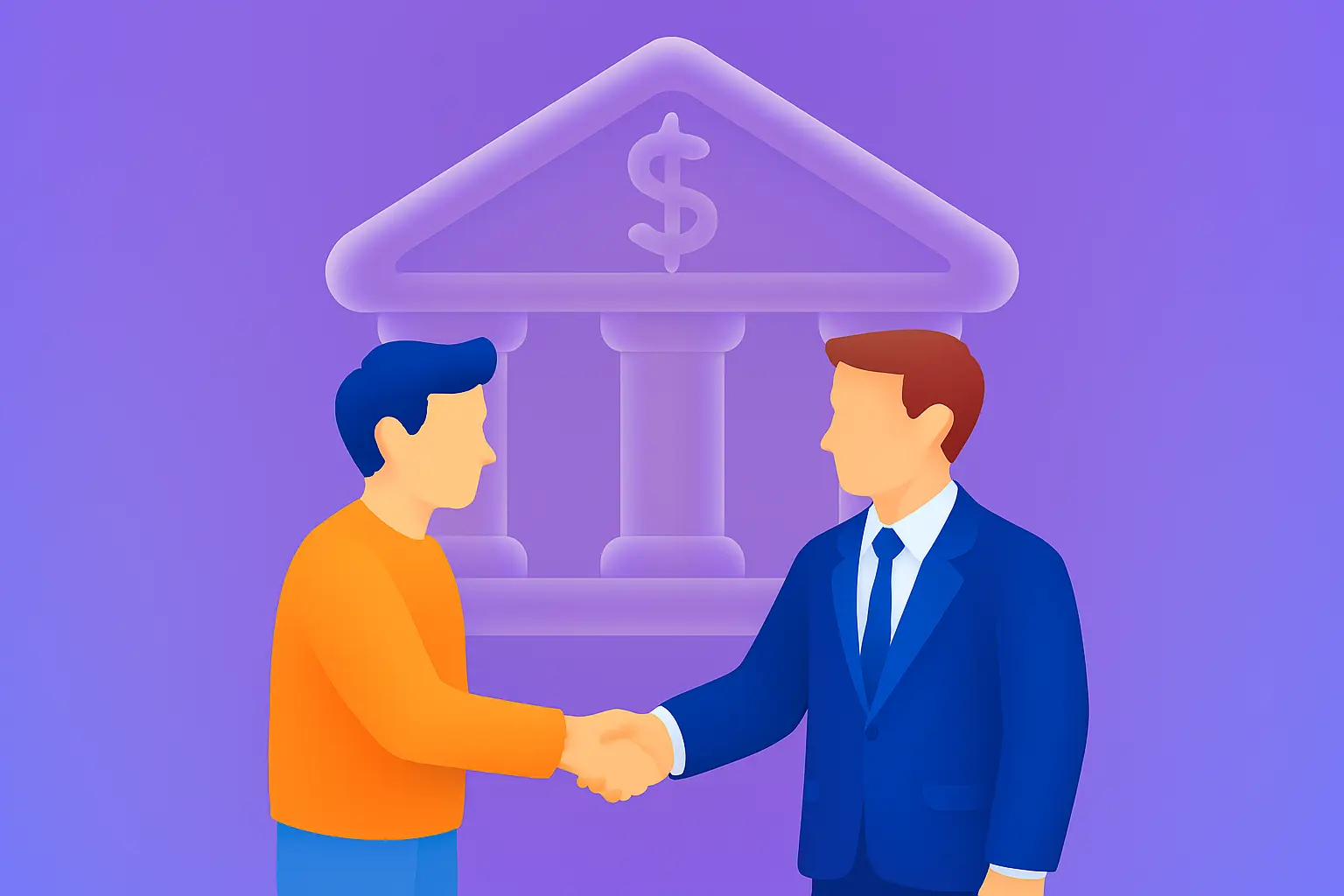What is Customer Retention? Metrics & How to Improve (2025)
- January 21, 2025
- 29 mins read
- Listen

Customer retention is a key metric for both B2B and B2C businesses. It helps evaluate the company’s product strengths, customer service, customer experience, and profitability. However, improving your customer experience greatly impacts customer retention for your business.
Businesses are facing challenges in retaining their customers. Are you struggling to retain your customers? Then you need to focus on how you handle your customers throughout their journey.
The better your customer experience, the longer they will stay.
According to Statista, the average customer retention rate is approximately 75.5% across all industries. See the rate of customer retention in different industries.
In this blog, we have covered customer retention definition or meaning, key metrics, how to retain customers, and examples of improving customer retention. Let’s explore.
What is Customer Retention?
Customer retention meaning: Customer retention means keeping your customers with your business for a specific time.
Customer Retention Definition: Customer retention is a metric that focuses on encouraging repeat purchases, providing quality customer service, and improving customer loyalty to reduce churn. However, it is the ability of a business to keep its existing customers with your brand over time.
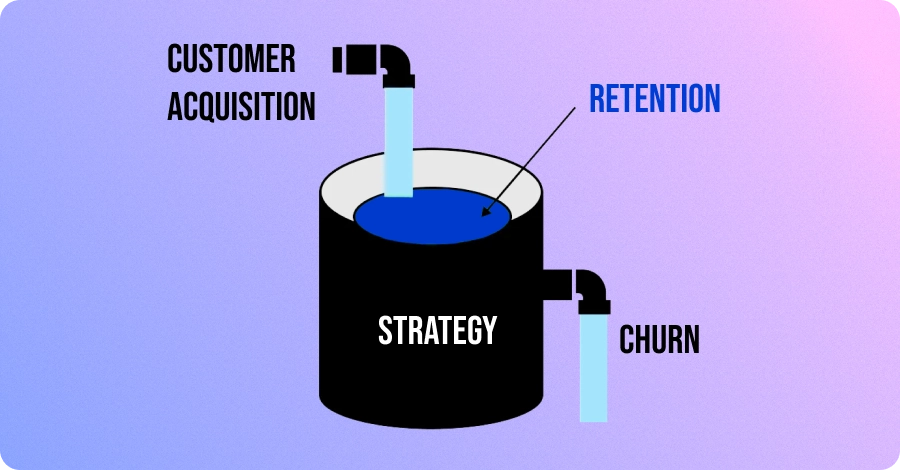
For instance, you have got new customers. Now, it’s time to focus on retaining and turning them into repeat buyers. In this case, you need to ensure a better customer experience. But How? Meeting your customer expectations, building a strong customer relationship, and offering the best customer services are essential.
If you can’t ensure those, your churn rate will be higher and your retention rate will be lower.
In this regard, AI-powered chatbot plays a crucial role in managing all of your customer’s expectations from a single platform. It ensures omnichannel customer service and a more personalized customer experience.
Why is Customer Retention Important?
Customer retention is important for several aspects of a business including branding, customer satisfaction, cost efficiency, competitive advantages, more loyal customers, profitability, and sustainability.
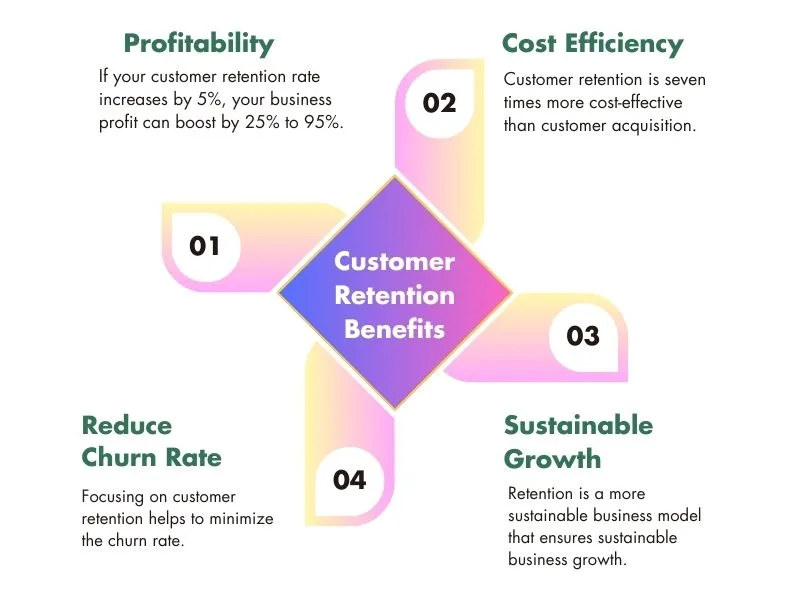
Well, look at the benefits of customer retention.
Profitability
Does customer retention impact profitability? Yes, customer retention has a direct impact on profitability. If your customer retention rate increases by 5%, your business profit can boost by 25% to 95%.
The more customers you retain, the more recurring revenue you generate.
Cost Efficiency
Is it cost-effective? Customer retention is seven times more cost-effective than customer acquisition. You don’t need to attract, educate, and convert new customers.
Selling your product to the customers with whom you already have a relationship is often a more effective way of growing revenue (upsell or cross-sell).
Sustainable Growth
Does it ensure sustainable growth? Retention is a more sustainable business model that ensures sustainable business growth. Customers who feel satisfied with your services will frequently buy from you.
Reduce Churn Rate
Can it reduce the customer churn rate? Focusing on customer retention helps to minimize the churn rate. The right strategy ensures a healthy retention rate. Let’s have a look at how to reduce the churn rate for your business.
Customer retention is the lifeblood of SaaS companies. However, no matter your industry, it is a core goal for every business, whether B2B or B2C.
What are the Metrics of Customer Retention?
Customer retention metrics are the units or variables to determine the performance of business operations including marketing, sales, customer service, and even product management.
In short, customer retention metrics are used to measure the opportunities to attract and retain customers to your business.
The customer retention data helps to fine-tune the entire customer journey and create a delightful user experience for both B2B and B2C businesses.
Top B2B Customer Retention Metrics
See the below table where the B2B customer retention metrics, what you measure, and formulas are included.
| Metric | Measure | Formula |
| Customer Retention Rate (CRR) | Percentage of customers retained over a specific period | (E−N)/S×100
E: Customers at end, N: New customers, S: Customers at start |
| Customer Lifetime Value (CLV) | Total revenue expected from a customer over their lifetime | Avg. Purchase Value × Purchase Frequency × Lifespan |
| Net Promoter Score (NPS) | Measures customer loyalty based on the likelihood of recommending | %\ Promoters – %\ Detractors |
| Churn Rate | Percentage of customers lost during a period | (Lost Customers / Customers at Start)×100 |
| Upsell and Cross-Sell Rate | Tracks frequency of upgraded or complementary product purchases | (Upsells / Total Customers)×100 |
| Engagement Metrics | Measures frequency of platform interactions or feature usage | Total Engagements / Active Customers |
| Renewal Rate | Percentage of customers renewing subscriptions | (Renewed Subscriptions / Eligible Renewals)×100 |
| Customer Health Score (CHS) | Composite metric evaluating satisfaction, usage, and interactions | Weighted Scores of Satisfaction, Usage, and Interactions |
| Time to Value (TTV) | The time it takes for a customer to realize value from the product | Time of Value−Time of Onboarding |
| Advocacy Metrics | Measures referrals, testimonials, or case studies | (Advocates / Total Customers)×100 |
These are the important customer retention metrics for B2B business. Now you can easily calculate your retention metrics by using those formulas.
Top B2C Customer Retention Metrics
Here, B2C customer retention metrics are given with the purpose of measurement and the required formulas.
| Metric | Measure | Formula |
| Repeat Purchase Rate (RPR) | Percentage of customers making multiple purchases | (Repeat Customers / Total Customers)×100 |
| Purchase Frequency (PF) | Tracks how often customers make purchases | Total Orders / Total Customers |
| Average Order Value (AOV) | Average revenue per transaction | Total Revenue / Number of Orders |
| Customer Loyalty Index (CLI) | Combines NPS, repeat purchases, and upselling to measure loyalty | Composite of NPS, Repeat Purchases, Upselling Rate |
| Customer Satisfaction Score (CSAT) | Measures customer satisfaction with a product or service | (Satisfied Responses / Total Responses)×100 |
| Time Between Purchases | Tracks the average time between repeat purchases | The sum of Time Intervals / Number of Intervals |
| Active Customer Rate | Percentage of actively purchasing customers | (Active Customers / Total Customers)×100 |
| Retention Revenue Rate | Revenue generated from repeat customers | (Revenue from Repeat Customers / Total Revenue)×100 |
| Customer Referral Rate | Frequency of customer referrals | (Referred Customers / Total Customers)×100 |
Several companies evaluate these retention metrics on an annual, quarterly, monthly, or weekly basis. The fast-moving SaaS companies may even look at these data daily.
Key Customer Retention Metrics to Measure
Tracking the retention metrics over time helps improve customer retention. Some of the metrics are mostly used by different industries which are provided below with the calculation process.
The following formulas will help you calculate them easily. All you need to do is put the desired numbers into the given formulas to get metrics instantly.
The below table enlists the most useful customer retention metrics for all types of businesses.
| Key Metrics | Formula |
| Customer Retention Rate | (Customers at the end of a period – new customers acquired during the period) / Customers at the start of the period x 100 |
| Customer Lifetime Value | Customer value x Average customer lifespan |
| Customer Churn Rate | (No. of customers at the start of the year – No. of customers at the end of the year) / No. of customers at the start of the year x 100 |
| Repeat Purchase Rate | No. of returning customers / No. of total customers x 100 |
| Net Promoter Score | % of Promoters – % of Detractors |
| Product Return Rate | No. of units sold that were later returned / Total no. of units sold x 100 |
| Loyal Customer Rate | No. of repeat customers / Total customers x 100 |
| Customer Satisfaction Score | (No. of satisfied respondents / Total no. of respondents) × 100 |
| Annual Days Sales Outstanding | (Accounts receivable / Annual revenue) × 365 Days |
| Monthly Recurring Revenue | Average revenue per account x Total accounts in a month |
Now, take a look at how to calculate the metrics of customer retention using formulas.
Customer Retention Rate (CRR)
Customer Retention Rate is the most straightforward metric for measuring customer retention. It helps to find the percentage of loyal customers to your business over time. After calculating the CRR, you can see how effective your current strategy is to retain your customers.
What You Measure: Rate of the retained customers of a business over a specific time.
Customer Retention Formula:
Customer retention rate = (Customers at the end of a period – new customers acquired during the period) / Customers at the start of the period x 100
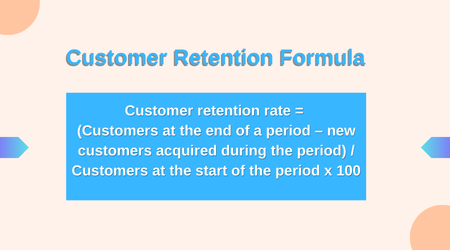
Customer Lifetime Value (CLV)
The longer a company retains loyal customers, their lifetime values become higher.
Customer lifetime value measures how much revenue you can generate from customers during their lifetime. It’s a metric to track consistently whether you sell individual products or services.
What You Measure: Revenue generated by the most loyal customer
Customer Lifetime Value Formula:
Customer lifetime value = Customer value x Average customer lifespan
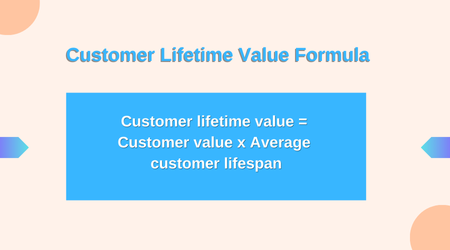
Here, consider a specific period-
- Customer value = Average purchase value x Average number of purchases
- Average purchase value = Total revenue / Total no. of purchases
- Average no. of purchase = Total no. of purchases / Total customer no.
- Average customer lifespan = Average no. of years the customer is active / Total no. of customers
Customer Churn Rate
Churned customers are those who stopped using your service. So it is one of the crucial metrics to measure your customer retention. When a company faces a high churn rate, it faces a major challenge to retain its customers.
For example, some of your customers might stop using your service because they may have gone through different challenges. It could be their businesses being acquired, they went bankrupt or they chose other service providers.
If your customer churn rate is more than 5 to 7%, then it’s time to rethink.
The main thing is to identify their problems first to reduce your churn rate. Either your product quality or the customer experience with your business can be evaluated.
What You Measure: Rate of customers lost over a specific period.
Customer Churn Formula:
Customer Churn Rate = (No. of Customers at Start of Year – No. of Customers at End of Year) / No. of Customers at the Start of Year x 100
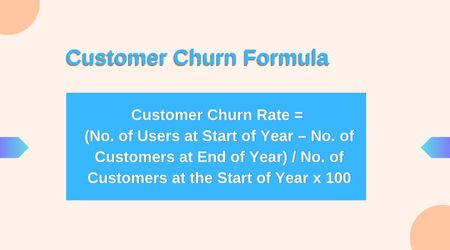
Repeat Purchase Rate
The repeat purchase ratio measures the rate of customers that come back to buy from your company again. This metric is a direct indicator of customer loyalty.
By calculating the repeat purchase rate, you can find out which types of customers are making the most repeat purchases. It helps to adjust your target buyer persona for marketing.
Repeat Purchase Rate Formula:
Repeat Purchase Rate = No. of Returning Customers / No. of Total Customers x 100
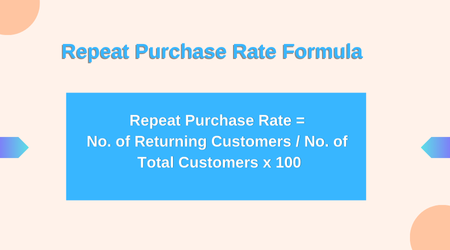
Net Promoter Score (NPS)
NPS is a qualitative measure of customer satisfaction and how likely the customers are to refer your business to others. It is a customer loyalty score, ranging from -100 to 100. You can explore what is a good Net Promoter Score.
If you compare your Net Promoter Score to the rate of revenue growth and customer churn, you can predict the potential growth through referral and retention.
According to the London School of Economics, “An average NPS increase of 7% correlates on average with a 1% growth in revenue.”
It’s just a simple question you can ask your customer to determine the score like “How likely are you to recommend us to a friend or colleague?”
Net Promoter Score Formula:
Net Promoter Score = % of Promoters – % of Detractors
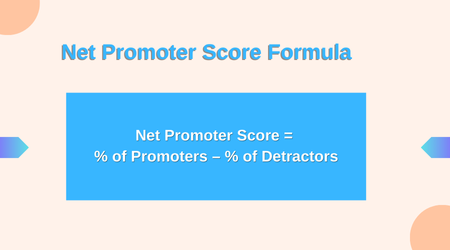
Product Return Rate
The product return ratio measures the rate of returned products. Though the products could be returned for various reasons, the ultimate goal is to keep this as low as possible.
In customer retention strategy, product returns can be extremely problematic, especially for the B2B business. Generally, the product return rate of B2C retailers for online stores is 20% and in-store 9%.
The product return rate is the most important data for the customer success team to find out the exact problem.
Product Return Rate Formula:
Product Return Rate = No. of Units Sold That Were Later Returned / Total No. of Units Sold x 100
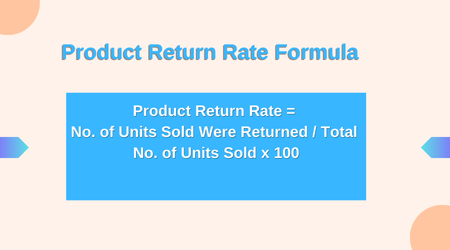
Loyal Customer Rate
Your loyal customers are the most valuable so it’s crucial to know how many customers are loyal to your brand. This metric measures the number of buyers who made repeat purchases during a month, quarter, or year.
This includes both new and existing customers. The loyal customers of your business act like brand ambassadors. You can have a look at the ways to increase your loyal customer base.
Loyal Customer Rate Formula:
Loyal Customer Rate = No. of Repeat Customers / Total Customers x 100
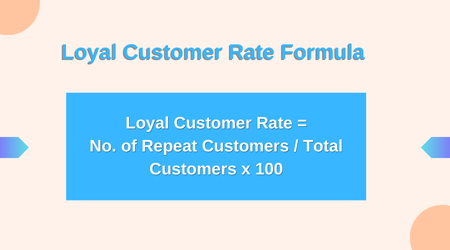
However, the above-mentioned retention metrics are mostly used for all types of businesses. We have another blog on how to calculate customer retention metrics. Here, you’ll find a detailed calculation process for more retention metrics.
10 Powerful Ways to Improve Customer Retention
How to improve customer retention? Here are some effective ways to improve customer retention. You need to implement the right strategy at the right time for your business.
But before creating a customer retention strategy, you should consider some key things like your business’s-
- type and size,
- product or service,
- targeted customer profile,
- the volume of your customers,
- the current retention metrics data.
Here, each strategy is designed to be customer-focused, actionable, and easy to implement.
- Providing Exceptional Customer Service & Support
- Ensuring More Personalized Customer Experience
- Meeting Customer Expectations & Satisfaction
- Automating Your Customer Engagement Process
- Building Trust with Your Customers
- Keeping Your Customers Posted & Engaged
- Offering Something Special for Your Customers
- Introducing On-demand Features & New Product Line
- Continuously Tracking Your Retention Metrics & Adjusting the Strategies
- Ensuring a Positive Experience for Your Employee
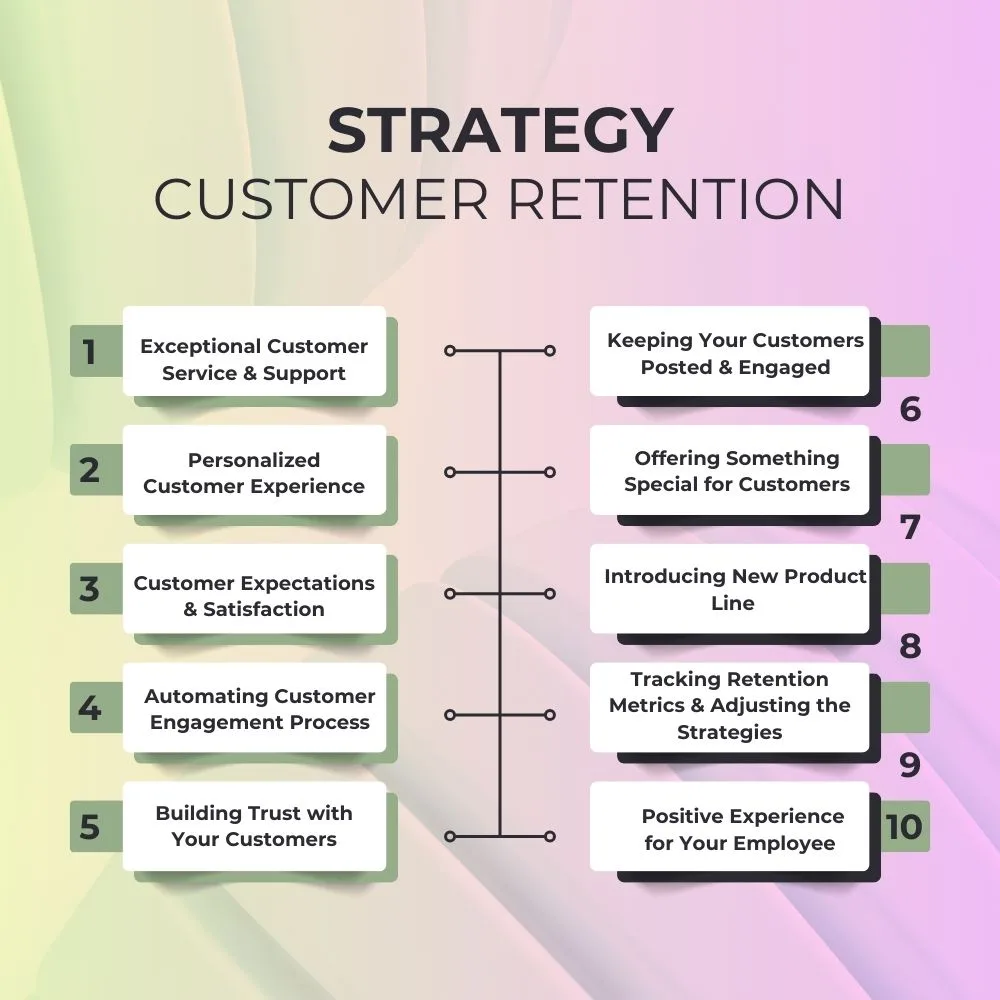
Let’s explore some of the best practices for customer retention.
1. Providing Proactive Customer Service & Support
Customer service and support of a business greatly impact customer retention. When your customers get the desired level of services, they feel comfortable staying with your brand.
Are customer service and support similar? Simply, No.
Customer service deals with the entire customer experience throughout their lifecycle. Meanwhile, customer support focuses on helping customers to solve their technical problems.
Okay, but how can you ensure exceptional customer service and support? Let’s see the key actions to make it happen and shape your customer retention process.
- Adopt Artificial Intelligence (AI) for Proactive Solutions
- Improve Your Customer Onboarding Process
- Offer Omnichannel Customer Support
- Improve First Call Resolution (FCR)
- Respond Your Customer Queries Quickly
Let’s discuss how to improve customer retention with quality customer service and support.
-
Adopt Artificial Intelligence (AI) for Proactive Solutions
If you are still using the traditional customer service process or a customer service tool that is not up to the mark, you can’t make it, can you?
Well, a live chat for your website can turn your customers into sales and they can receive expected services and support through this channel. But if you can’t ensure that customers get immediate responses and solutions, will it be fruitful at all?
In this case, integrating an AI chatbot with your live chat will be the best solution. It’ll help your business to offer quality customer service that drives the desired level of customer retention.
For example, stc is the largest telecommunication company in Kuwait. This company has a 2.3 million customer base. With the AI-powered chatbot, it has been automating the entire customer journey, making customer support smarter and faster than ever, and ensuring effortless customer support.
Learn more: Top 10 Customer Retention Software for 2025
-
Improve Your Customer Onboarding Process
Retention is not only about nurturing your existing customers but also welcoming your new customers with a better experience.
First impressions matter!
Always try to make the onboarding process simple and informative. Walk your customers through the steps to get the most out of your product or service. In this regard, you can use videos, tutorials, or welcome messages to help them.
You can also greet your customers with personalized welcome messages by using chatbot templates.
-
Offer Omnichannel Customer Support
Your company should be accessible on all platforms that your customers use. Whether it’s email, chat, phone, or social media, ensure you’re available to assist them.
But how can you ensure omnichannel customer support? In this case, you can use a tool that offers omnichannel customer experience.
Well, the Smart Inbox with instant messaging capabilities can make your service faster, smarter, and more effective.
-
Improve First Call Resolution (FCR)
Imagine a scenario of customer support-
Agent: Click the Blue button.
User: I don’t see a Blue button.
Agent: It should be on the right side of your screen.
User: I’m not sure we’re on the same page.
Do you think this is seamless customer support? Of course Not!
If you can’t avoid miscommunication and resolve your customers’ issues immediately, your customers feel dissatisfied. And, this drives your customers to leave.
The co-browsing tool helps to ensure seamless customer support to overcome the scenario.
-
Respond Your Customer Queries Quickly
Time is crucial! So, aim to address customer concerns as fast as possible to build trust and satisfaction.
For businesses, it’s a common scenario that you have to deal with a lot of customer queries regularly.
When you respond to the queries immediately after receiving them, your customers will feel you are working actively towards the solutions. In this regard, using canned responses is one of the most effective solutions.
2. Ensuring Personalized Customer Experience
You have to make your customers feel valued and understood. That’s why personalized experience matters. Customer experience touches every phase of the entire journey. So, ensuring the best practices from the onboarding to after-sales service is crucial.
According to McKinsey, 71% of customers expect brands to deliver personalized experiences from the very first moment.
Does personalized experience matter in customer retention? Yes, if you ensure a personalized customer experience, your customer retention rate will be healthy.
Let’s see some touchpoints of the customer journey where you should focus.
- Seamless Shopping Experience with AI Agent
- Personalize Support Interaction
- Ease the Return Process
- Acknowledge Your Customer Complaints
- Follow Up After a Purchase
Let’s explore more about how to improve customer retention with personalized customer experience.
-
Seamless Shopping Experience with AI Agent
The ecommerce industry should practice it to nurture their existing customers for future purchases. In this case, an AI-powered chatbot or AI Agent for your website plays a crucial role.
For example, Le REVE is a well-known fashion brand using an AI chatbot to provide the best online shopping experience to its customers.
When users visit the website, they can interact with the website chatbot to learn about product availability, color, sizes, and pricing. And they can complete their order through the chatbot.
It provides a better experience for customers by making online purchases more convenient. Next time customers come back to buy again, the chatbot can easily acknowledge users’ choices and suggest relevant products based on their purchase history.
-
Personalize Support Interaction
While communicating with your customers, try to use their names. It helps them to feel special. But how do you get their name? So creating your customers’ user accounts is vital.
Sometimes, you can use personalized conversations based on the situation including-
For late response: Sorry for the late response notes.
For any inconvenience: Sorry for the inconvenience- apology email.
To keep waiting: Thank You for Your Patience messages.
-
Ease the Return Process
For ecommerce businesses, the return procedure should be smoother. If you can’t ensure it, you will lose a considerable number of customers.
So make sure of an easy return process and let your customers know about the return status. This practice helps your business to increase the online shopping experience as well as build trust levels.
-
Acknowledge Your Customer Complaints
Complaints are opportunities. You should listen to your customers, solve their issues promptly, and turn them into loyal advocates.
You have to prioritize your customers and try to understand their pain points. Sometimes, businesses face challenges in managing difficult customers including angry customers, indecisive customers, and so on.
Besides, your customer service team should handle customer complaints smartly. If you can’t turn your customer complaints into resolutions, your churn rate will be higher.
-
Follow Up After a Purchase
Following up after a purchase is a critical step in building lasting relationships with your customers. When done right, it can reinforce their trust, ensure satisfaction, and encourage them to return.
Here’s how you can make your follow-up process more effective and impactful:
- Send a Personalized Thank You Message
- Check-In After the Purchase
- Stay Connected with Your Customers
“Let your customers know they matter to you, and they’ll keep coming back.”
3. Meeting Customer Expectations & Satisfaction
Meeting customer expectations and ensuring satisfaction means delivering on your promises consistently to your customers. First, you need to measure the customer satisfaction metrics. Then you can attempt the required ways to improve it.
- Build a Customer Profile
- Know Your Customers
- Create an Achievable Roadmap with Your Customers
- Ask for Your Client’s Feedback
Let’s learn more how to retain customers with ensuring customer satisfaction.
-
Build a Customer Profile
It’s crucial to understand your customers. The very first step is to create detailed profiles for them. This involves gathering insights about their preferences, habits, and challenges.
For example, ask yourself:
- What motivates your customers?
- What problems are they trying to solve?
When you know your audience well, you can offer services to match their needs perfectly. You can also go through how to create a customer profile.
-
Know Your Customers
Your customers are the heart of your business. Use tools like surveys and interviews to hear directly from them. Analyze their buying behavior to identify trends and patterns.
Ask questions like,
- What features do you love most?
- What would make your experience better?
This knowledge helps you focus on what truly matters to them.
-
Create an Achievable Roadmap with Your Customers
Think long-term! Show your customers how your product or service can grow with them.
For instance, if they’re using a basic plan now, demonstrate how upgrading in the future will benefit them. This creates trust and shows that you care about their success.
-
Ask for Your Client’s Feedback
Feedback is a gift. Encourage your customers to share their thoughts through reviews, surveys, or conversations.
Act on their suggestions and keep them informed about the improvements you’re making. When customers see their feedback implemented, it strengthens their loyalty.
Look over customer feedback management and find the best practices and tools to improve your customer feedback.
4. Automating Your Customer Engagement Process
Set up your customer engagement systems to send personalized reminders, thank-you emails, or updates automatically. It helps to improve retain your customers.
For example, after a purchase, you can send a follow-up email thanking them and providing tips on how to use the product. Automation ensures consistency while saving you time.
Deploying chatbots as a part of user engagement strategies can bring significant benefits to your business. 80% of businesses said they currently use or are planning to use chatbots before the end of the year.
5. Building Trust with Your Customers
Building trust creates a strong emotional connection with your customers, making them more likely to stay loyal to your brand. It is one of the effective ways to retain your customers.
When customers trust that you consistently deliver value and prioritize their needs, they feel confident choosing your business repeatedly.
-
Build a Strong Relationship with Your Customers
Trust is built over time through meaningful interactions. Reach out regularly, not just to sell, but to check in. Ask how they’re finding your product or if there’s anything you can do better.
-
Build a Strong Customer Community
A thriving customer community drives loyalty. Create spaces like Facebook groups, forums, or exclusive events where your customers can connect.
For example, if you sell software, a user group can be a place to share tips, ask questions, and celebrate wins together.
6. Keeping Your Customers Posted and Engaged
Keeping your customers informed and engaged strengthens their connection to your brand. Regular updates, personalized messages, and educational content help maintain interest and show that you’re invested in their success.
When customers feel consistently engaged and informed, they are more likely to stay loyal and continue choosing your business over competitors. How to keep your customers engaged with your brand?
- Connect Regularly with Your Customers
- Send Your Company’s Newsletter
- Educate Your Customers
- Segment Customers to Deliver the Right Content
- Send Engaging Emails to Your Customers
- Upsell & Cross Sell to Your Existing Customers
These are the effective ways to keep your customers engaged. The most important thing is to maintain a consistency. Let’s discuss.
-
Connect Regularly with Your Customers
Make it a habit to stay in touch with your customers. A friendly call, an email with helpful updates, or even a shoutout on social media can go a long way in keeping your connection strong.
-
Send Your Company’s Newsletter
Keep your customers in the loop with newsletters packed with value. Share product updates, special offers, or customer success stories.
-
Educate Your Customers
Customers stick around when they see the full value of your product. Provide tutorials, guides, or webinars that teach them how to get the best results.
-
Segment Customers to Deliver the Right Content
Not every customer is the same. Use what you know about their preferences to send messages just for them. In this case, customer segmentation is vital. You can take a look at the effective ways to segment your customers.
-
Send Engaging Emails to Your Customers
Emails should do more than inform your customers. Use clear headlines, eye-catching visuals, and compelling calls to action.
-
Upsell & Cross Sell to Your Existing Customers
Your current customers are more likely to buy from you again. Offer them products or services that enhance their experience.
7. Offering Something Special for Your Customers
Offering something special, like discounts, loyalty rewards, or personalized gifts, makes customers feel appreciated and valued. These gestures create a positive experience that encourages them to return and strengthens their emotional connection with your brand.
When customers see tangible benefits and exclusive perks, they are more likely to stay loyal and continue doing business with you. What are the offerings that make your customers feel special?
- Offer Buy Now, Pay Later Options
- Give Them Discounts or Credits
- Reward Your Loyal Customers
- Celebrate Your Customer Milestones
Here are some practices to make your customers feel special. It helps to improve your customer retention.
-
Offer Buy Now, Pay Later Options
Make it easier for customers to say yes by offering flexible payment options. This is especially useful for higher-priced items.
-
Give Them Discounts or Credits
Encourage repeat purchases with exclusive discounts or store credits. For example, send a message like, We miss you! Here’s 15% off your next purchase.
-
Reward Your Loyal Customers
Loyal customers are your best asset. Create a program where they earn points for purchases, referrals, or reviews, and redeem those points for rewards. This keeps them engaged and excited.
-
Celebrate Your Customer Milestones
Recognize special occasions like birthdays, and anniversaries, or purchase milestones with personalized offers.
For example, Happy 1-Year Anniversary with Us! Here’s a special gift to celebrate.
8. Introducing On-Demand Features & New Product Lines
Introducing on-demand features and new product lines shows your customers that you’re committed to evolving with their needs and staying relevant.
It gives them more options and flexibility, making your offerings more valuable and focused on their preferences.
When customers see that your business listens and innovates to meet their expectations, they are more likely to remain loyal and engaged.
-
Offer On-Demand Features to Your Customers
Let your customers customize your product or service to meet their unique needs. This flexibility shows that you’re committed to making their experience perfect.
-
Launch Subscription Services
Subscriptions make life easier for both you and your customers. They provide convenience and guarantee ongoing value. You should offer subscribers perks like discounts or early access to new features.
9. Continuously Tracking Retention Metrics & Adjusting Strategies
Continuously tracking retention metrics helps you identify patterns and pinpoint areas where customers may be disengaged.
By analyzing this data and adjusting your strategies, you can address issues proactively, such as improving products or personalizing communication.
So, staying responsive to your customer behavior ensures their needs are met, building trust and encouraging long-term loyalty.
-
Spot the Customers Who Might Leave
Analyze your data to spot warning signs of customer churn, like decreased engagement or late payments. Reach out with offers or support to retain them.
-
Collect and Analyze Your Business Data
Data always helps you stay ahead of the game. You should regularly track metrics like customer satisfaction, retention rates, and purchase patterns. And based on the insights, you should refine your strategies.
10. Ensuring a Positive Experience for Your Employee
Your employees are the face of your business. Happy employees lead to happy customers.
When they’re happy and motivated, they’ll provide better service to your customers. Invest in their training and show appreciation for their efforts.
By following these strategies, you can build stronger relationships with your customers and keep them coming back for more.
Remember, customer retention is not a one-time task, it’s an ongoing commitment!
Customer Retention Tips for BFSI, E-commerce & Telecom
We’ve discussed effective retention strategies in the earlier section. Although several customer retention practices are common for all types of business, some of them are industry-based.
Besides, the retention strategies may also differ from small to large-size businesses. You can look at the ideas for improving customer retention for small businesses.
Let’s see some customer retention tips for the banking, finance, Insurance, ecommerce, and telecom industries.
| Industry | Tips & Tricks | Action | Example |
| Banking, Finance & Insurance | Personalized Experiences | Offer customized products using data analytics. | Suggesting a loan based on transaction history. |
| Reward Programs | Provide loyalty rewards for usage or referrals. | Cashback on credit card usage or discounted premiums. | |
| Proactive Customer Support | Resolve issues instantly with chatbots or live chat. | Alerts for low balances or unusual activity. | |
| E-commerce | Exclusive Member Benefits | Create programs with perks like free shipping or early access. | Amazon Prime’s free shipping and exclusive deals. |
| Personalized Recommendations | Use AI to suggest products based on purchase history. | You might also like a section for similar products. | |
| Timely Engagement | Send reminders or discounts for abandoned carts. | Offering a 10% discount after 24 hours of cart abandonment. | |
| Telecom | Loyalty Plans | Reward customers with free upgrades or bonuses for long-term usage. | Free 5G access after 2 years with the provider. |
| Proactive Issue Resolution | Address issues quickly using live support and compensation. | Offering bill credits for service outages. | |
| Flexible Plans | Allow customization of plans based on usage. | Pay-as-you-go or data rollover options. |
However, these industry-specific retention practices are mostly used to improve the overall customer experience and drive customer retention.
Do you want to learn more about customer retention strategies for the banking industry? Go through and implement the right strategy at the right time.
A Successful Customer Retention Example
Here is an example of how a finance company improved customer retention by enhancing customer experience as well as customer service.
Challenges: Higher Churn Rate
Here are some challenges the company faces in customer retention.
- High Customer Expectations
Customers demand instant responses to their queries, such as account balance inquiries, loan status, or policy details. Long wait times often lead to frustration.
- Operational Inefficiencies
Traditional customer service teams struggle to handle high call volumes and repetitive queries, leading to delays and errors.
- Churn Risk
Customers often switch to competitors offering faster and more personalized support.
Action: Focusing on Improving Customer Experience
Kuwait Finance House introduced REVE Chat AI Chatbot Powered by Brain AI to handle customer queries and streamline their customer support process. This helped the company to improve the overall customer experience.
- 24/7 Support
The chatbot was designed to answer frequently asked questions (FAQs) instantly, such as balance inquiries, transaction histories, and branch details. This ensured customers received help anytime they needed it.
- Personalized Experiences
The chatbot analyzed customer data to provide required suggestions, such as recommending savings plans based on spending patterns or offering pre-approved loan options.
- Proactive Communication
It sent timely reminders for upcoming loan payments, credit card due dates, and policy renewals, reducing missed payments and enhancing customer convenience.
- Feedback Collection
The bot regularly asked customers for feedback after interactions and used this data to improve its responses and suggest service enhancements.
Results: Reduced 20% Churn Rate
- Reduced Wait Times
The chatbot successfully handled over 70% of customer queries, significantly reducing response times and improving customer satisfaction.
- Enhanced Customer Engagement
Personalized recommendations and proactive reminders made customers feel valued and understood, increasing their trust in the company.
- Operational Efficiency
Automating repetitive tasks allowed human agents to focus on complex issues, leading to faster resolution of critical cases.
- Lower Churn Rate
By delivering a seamless, responsive, and personalized experience, the company saw a 20% decrease in customer churn within six months.
Several companies like stc Kuwait, bKash, Guardian Life Insurance, Le REVE, Unity Bank, Legrand, and so on improved their customer retention rate by using the REVE Chat’s AI-powered Chatbot.
Takeaway for Businesses
Customer retention is not just a metric, it’s the foundation of sustainable growth and long-term success for any business. From tracking essential retention metrics to implementing AI-powered tools, the retention process is smoother.
As discussed in this blog, focusing on exceptional service, personalized experiences, and continuous improvement helps to retain your customers.
Adopting advanced technologies enhances customer interactions. It provides instant support, predictive insights, and a seamless experience that keeps customers engaged and satisfied with your brand.
Remember, retaining customers is far more cost-effective than acquiring new ones. By investing in offering unique incentives, meeting customer expectations, and regularly analyzing retention metrics, you’re ultimately driving revenue growth.
Last but not the least! Your customers are your business’s greatest asset. Investing in chatbot technology is a smart move to improve customer retention, reduce churn, and stay ahead in a competitive market.
With the right retention approach, your business can thrive in 2025 and beyond.
Frequently Asked Questions
A good customer retention rate depends on your industry, but generally, a retention rate above 85% is excellent for most businesses.
If your rate is lower, don’t worry, it’s a great opportunity to identify areas for improvement. Focus on building strong relationships, delivering value consistently, and addressing customer pain points quickly to boost your retention rate.
Here are the 3R’s of customer retention including retention, reactivation and referrals. Retention means keeping your current customers happy by offering outstanding service and solving their problems efficiently.
Reactivation refers to re-engage customers who haven’t interacted with your brand recently by offering personalized incentives or reminders of your value.
Referrals means turning loyal customers into advocates who bring in new business by rewarding them for spreading the word.
These 3 R’s help you retain existing customers while also expanding your customer base effortlessly.
The customer retention model is a strategic approach for a business to predict, analyze, and improve the likelihood of customers staying loyal to your business over time.
It uses the data, customer behavior patterns, and engagement metrics to identify which factors drive retention and which lead to churn.
A customer retention model helps you focus resources on the most impactful areas, reducing churn and boosting customer lifetime value.
In short, a strong retention model enables you to build lasting relationships with your customers, ensuring sustainable business growth.
Retaining customers isn’t always easy, and you might face some challenges like Meeting Changing Expectations: Customers’ needs evolve, so it’s important to adapt quickly and offer new value. Then, Competition: With so many options available, staying ahead requires constant innovation and engagement. Moreover, Delivering Consistent Experiences: A single bad interaction can drive customers away, so prioritize consistency in quality and support.
Always try to stay connected with your customers, seek regular feedback, and keep improving your offerings to overcome these challenges.
Customer retention strategies are most effective when You’ve already built a solid customer base and want to maximize their lifetime value, Your industry has high competition, and keeping existing customers is more cost-effective than acquiring new ones. And you notice signs of disengagement, such as reduced purchases or low engagement rates.
Investing in retention is not just about keeping customers, it’s about building long-term relationships that drive sustainable growth.
The best way to determine what customer retention techniques will work best is to get to know your customers.
Ask them what they like and don’t like through customer research interviews, surveys, or feedback, and ask specific questions.
For example, if you think a feature on your site might be causing friction and churn, ask users about it. If you’re considering starting a loyalty program, ask customers about their favorite incentives and program structures.


